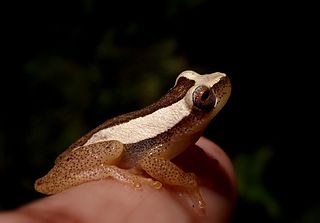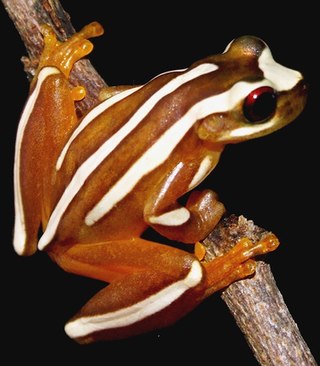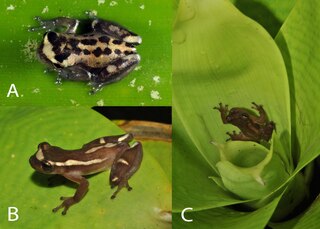Dendropsophus aperomeus is a species of frog in the family Hylidae. It is endemic to Peru and occurs on the Amazonian slopes of the Andes in northern and central Peru. Common name Balzapata treefrog has been coined for it.
Dendropsophus berthalutzae is a species of frog in the family Hylidae. It is endemic to southeastern Brazil and occurs in the coastal lowlands and the Serra do Mar in Espírito Santo, Minas Gerais, Rio de Janeiro, São Paulo, and eastern Paraná states. It is named in honor of Bertha Lutz, a Brazilian zoologist and feminist. Common name Bertha's treefrog has been coined for it.

Dendropsophus bogerti is a species of frog in the family Hylidae. It is endemic to the Andes of Colombia and occurs in the Cordillera Central in Antioquia, Caldas, and Chocó Departments. The specific name bogerti honors Charles Mitchill Bogert, an American herpetologist. Soon after its description in 1970, it was relegated to synonymy of Dendropsophus carnifex, but its species status was restored in 1997.

Dendropsophus branneri is a small hylid tree frog endemic to the Atlantic Forest region of Brazil. It feeds mainly on arthropods and is preyed upon by various invertebrates and vertebrates. Although currently classified by the IUCN Redlist as "least concern", D. branneri suffers rapid habitat loss due to residential development, agriculture, logging, and clearing for pastureland. Male D. branneri are noted for their fighting call, which differs significantly in frequency, duration, and pulses per call compared to their mate advertisement call. Males are also noted for their willingness to escalate physical altercations against other males, which includes kicking, pushing, and wrestling their opponent into non-dominant positions. Unlike most other frog species, D. branneri can breed in both temporary and permanent pools allowing it to inhabit a wide variety of habitats leading to its wide distribution.
Dendropsophus garagoensis is a species of frog in the family Hylidae. It is endemic to the eastern slope of the Cordillera Oriental in Boyacá Department, Colombia. Common name Garagoa treefrog has been proposed for it.

Dendropsophus haddadi is a species of frog in the family Hylidae. It is endemic to eastern Brazil, with its distribution ranging from northern Espírito Santo to Bahia, Sergipe, Alagoas, Pernambuco. The specific name haddadi honors Célio F. B. Haddad, a Brazilian ecologist and herpetologist.

Dendropsophus joannae is a species of frogs in the family Hylidae. It is known from the Pando Department, northern Bolivia, western Brazil, and Madre de Dios Region of southeastern Peru. It is similar to Dendropsophus leali but is smaller, has a shorter snout, more protuberant eyes, and more tuberculate dorsal skin. The specific name joannae honors Mrs. Jo Ann Oxley Foster, a BIOPAT patron supporting taxonomic research and nature conservation.

Dendropsophus marmoratus is a species of frog in the family Hylidae. It is found in the Amazon rainforest and montane forests in the eastern piedmont, in Bolivia, Brazil, Colombia, Ecuador, French Guiana, Guyana, Peru, Suriname, and Venezuela. Its natural habitats are subtropical or tropical moist lowland forests, intermittent freshwater marshes, and heavily degraded former forest. "Marmoratus" in Latin means "marble," perhaps referring to the dorsal coloring pattern. It is threatened by habitat loss.

Dendropsophus robertmertensi is a species of frog in the family Hylidae. It is found in the Pacific lowlands of El Salvador, Guatemala, and southeastern Mexico. A separate population exists in the Cintalapa Valley in Chiapas.
Dendropsophus stingi is a species of frogs in the family Hylidae. It is endemic to Colombia and occurs on the eastern slope of the Cordillera Oriental in the Boyacá Department. The species was named after celebrity musician Sting in recognition of his "commitment and efforts to save the rain forest". Despite this, common name Kaplan's Garagoa treefrog has been coined for it.
Dendropsophus subocularis is a species of frog in the family Hylidae. It is found in eastern Panama and northwestern Colombia to the Magdalena River Valley. It occurs from the sea level to at least 800 m (2,600 ft), and perhaps as high as 1,650 m (5,410 ft) above sea level.
Dendropsophus juliani is a species of frogs in the family Hylidae. It is endemic to northern Bolivia.

Dendropsophus arndti is a species of "clown tree frogs" described in 2017 that lives in the Amazon basin of Bolivia. The specific name arndti honors professor Rudolf G. Arndt, in recognition of his financial support for research and nature conservation.
Dendropsophus shiwiarum is a frog in the family Hylidae. It is endemic to Ecuador and Colombia. Scientists think it may also live in nearby parts of Peru.

Dendropsophus nekronastes is a frog in the family Hylidae. It is endemic to South America. Scientists know it solely from its type locality in Bahia, Brazil, 303 meters above sea level.
Dendropsophus frosti, the acre tree frog, is a frog in the family Hylidae. It is endemic to in South America. Scientists have seen it at two sites, one in Colombia and one in Peru.
Dendropsophus counani is a frog in the family Hylidae. It is endemic to Brazil, French Guiana, Suriname, and Guyana.
Boana ventrimaculata, The Yasuní tree frog, is a frog in the family Hylidae, endemic to Ecuador and Brazil. Scientists have seen it between 64 and 1035 meters above sea level.
Dendropsophus reichlei is a frog in the family Hylidae endemic to Bolivia, Peru, and Brazil.

Dendropsophus bromeliaceus, or Teresensis' bromeliad frog, is a frog in the family Hylidae, endemic to Brazil. Scientists have only seen it in the mountains in the Reserva Biológica Augusto Ruschi.\








